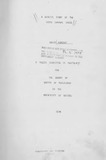| dc.description.abstract | A study of the production traits of the Kenya Sahiwal cattle was conducted with a view to obtaining reliable parameters for planning breeding programmes in this breed.
Altogether, 3993 normal lactation records of 1183 Sahiwal cows completed in the period 1963-1971 at the National Sahiwal Stud were included. The data were analysed by least squares procedures (Harvey, 1966).
The results of the analyses are summarised below:
a) The LSQ means for 305 day milk yield, fat percentage and fat yield were 1455 + 10 kg, 5.00 + 0.02 percent and 72.26 + 0,57 kg respectively. These means are comparable to other Bos indicus herds in the tropics although the fat percentages were somewhat lower than those reported earlier in tropical cattle.
b) Milk and fat yields were influenced to a similar extent by age, parity, calving season and calving year, in all the cases the effects of these independent variables were highly significant.
c) Fat percentages were influenced by parity and year of calving but not by season of calving. The contribution to total variance of fat percentage by the above stipulated effects was small.
d) Different ways of classifying calving period*/ere tested and found to reduce the error mean squares to a similar extent. However, the highest Rz value was
obtained when each month of calving in each year was regarded as a separate season. Suitability of the different classifications is discussed.
e) The mean lactation length, dry period and calving interval were 274 + 0.8, 149 + 1.8 and 412 + 1.4 days, respectively. Current lactation lengths influenced milk and fat yield without affecting the fat percentage significantly. Dry periods influenced all the three traits while calving intervals did not influence fat percentage when dry period and lactation length were included in the same model.
f) The mean weight at calving was 396 + 0.97 kg. Weight increased steadily up to the fifth lactation and then stabilised. Milk yield was influenced by weight at calving while weight at calving itself war influenced by age at first and second calving, parity, calving period and sires.
g) Heritabilities were as follows:- Milk yield 0.23 + 0.04 fat percent 0.16 +0.04, fat yield 0.23 + 0.04, lactation length 0.16 + 0.03, dry period 0.19 + 0.03, calving interval 0.08 + 0.03 and weight at calving 0.50 + 0.19. Repeatabilities as well as genetic and phenotypic correlations among the traits were calculated.
h) The current breeding plan at the National Sahiwal Stud was appraised using heritabilities and repeatctbilities found in this study. It was concluded that at present, too small a section of the herd was used as a test herd. Young bulls were, as a'result, inaccurately tested.
i) Alternative breeding plans were calculated and evaluated. Increasing herd size resulted in larger daughter groups per tested bull and higher numbers of young bull tested. The paths, bulls to breed young bulls and cows to breed young bulls, were found to account for most of the genetic progress in these plans.
Sahiwals are quite adapted to the semi-arid conditions that exist in Naivasha. When comparing cows that calved in different periods and at different ages, it is important to correct the data for variations due to these effects.
Correction of the data for variations due to lactation lengths, dry period and calving interval is not recommended although milk and fat yields are influenced significantly by these effects.
The heritabilities, repeatabilities, generic and phenotypic correlations obtained suggested that milk and fat yields can be improved through direct selection exclusively for milk. Fat testing does not seem to be warranted in this herd. In order to maximise genetic progress it is necessary to increase the herd size and to utilise a larger part of the herd for testing young bulls | |

